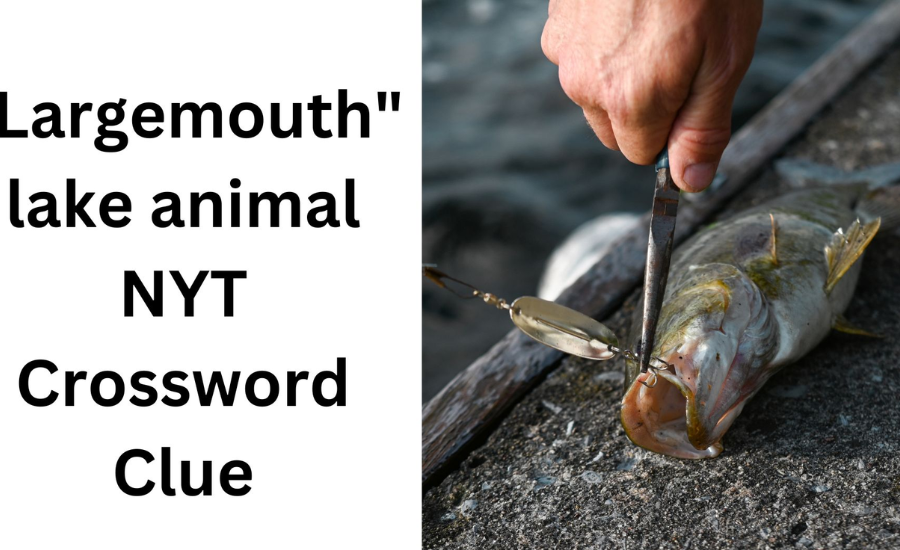How the Largemouth Lake Animal NYT Captivates Attention
Introduction
Within tranquil lakes, where water reflects the sky, resides an extraordinary creature that captivates the imaginations of photographers, intrigues nature enthusiasts, and motivates conservationists. This enigmatic being, known as the largemouth lake creature, has recently become a focal point for prominent media outlets such as The New York Times. What makes this creature so enthralling? In this comprehensive exploration, we delve into the allure of the Largemouth lake animal nyt creature, examining its ecological significance, the factors contributing to its growing prominence, and offering insights into how to best appreciate or photograph this fascinating animal in its natural habitat.
The Allure of the Largemouth Lake Animal NYT

The phrase “Largemouth lake animal,” often highlighted by The New York Times, evokes a sense of majesty and enigma. This designation primarily refers to the largemouth bass, a species celebrated for its impressive size and striking appearance. However, it is not merely the bass’s physical attributes that draw interest; its behavior and role within its ecosystem are equally compelling. The largemouth bass is a pivotal component of its aquatic environment, playing a key role in controlling the populations of smaller fish and contributing to the overall ecological balance.
Nature photographers and enthusiasts are particularly attracted to the Largemouth lake animal nyt due to its visually appealing qualities. The bass’s wide mouth, robust body, and the ripples it creates in the water offer exceptional opportunities for capturing stunning images. Documenting this creature in its natural setting requires patience and a discerning eye, a challenge that many photographers eagerly undertake. The dynamic interactions of the lLargemouth lake animal nyt with its environment provide a rich subject for those dedicated to capturing the beauty of wildlife.
Exploring the Common Living space of the Largemouth Lake Creature NYT
The Largemouth lake animal nyt flourishes in warm, still waters such as lakes, ponds, and slow-moving rivers. These environments provide essential cover and food sources, crucial for the bass’s survival and growth. Aquatic vegetation, submerged logs, and rocky structures offer necessary shelter and hunting grounds, creating a complex and thriving habitat.
Protecting these habitats is vital for environmental advocates. The condition of freshwater ecosystems is closely tied to the health of the largemouth bass population.Threats such as pollution, habitat degradation, and climate change pose significant risks. Advocates who champion clean water initiatives and promote sustainable practices play a crucial role in safeguarding these environments for future generations. Their efforts help ensure that the delicate balance of these ecosystems is maintained, allowing the largemouth bass and other species to thrive.
The Largemouth Bass in Cultural Context
Beyond the pages of The New York Times, the largemouth bass has made a notable impact on popular culture. It frequently appears in fishing tournaments, documentaries, and artistic representations. As a prized sport fish, it draws anglers from across the globe. Fishing for the largemouth bass is more than a leisure activity; it is an experience that demands skill, patience, and a profound respect for nature.
The lore surrounding the largemouth bass, including record-breaking catches and captivating myths, fuels the imagination and inspires countless adventures. Its presence in popular culture helps raise awareness of its ecological importance and fosters a deeper connection to the natural world. The largemouth bass serves as a symbol of both the joys of sport fishing and the need for environmental stewardship.
Techniques for Photographing the Largemouth Lake Animal NYT
Photographing the largemouth bass presents unique challenges and rewards for wildlife photographers. Patience and a thorough understanding of the bass’s behavior and habitat are essential. Optimal lighting conditions, often found early in the morning or late in the afternoon, are when the fish are most active and provide the best opportunities for capturing dynamic images.
High-quality equipment, such as a telephoto lens, is crucial for documenting the intricate details of the bass’s scales and the reflective qualities of its environment. Experimenting with various angles and settings can highlight the bass’s vibrant colors and dynamic movements. By carefully considering composition and lighting, photographers can create compelling images that showcase the beauty and vitality of the largemouth bass.
Respecting the habitat while photographing is equally important. Approaching the area slowly and using natural cover helps avoid startling the fish, minimizing disturbance to the ecosystem. By being mindful of their impact, photographers can contribute to the protection of these delicate environments while documenting the remarkable presence of the largemouth bass.
Ecological Role of the Largemouth Bass
The largemouth bass occupies a critical position in freshwater ecosystems as an apex predator. It plays a crucial role in controlling the populations of smaller fish and invertebrates, preventing any one species from becoming excessively dominant. This balance is essential for maintaining the health of aquatic plants and other organisms within these environments.
Recent studies have shown that the largemouth bass can also serve as an indicator species, providing valuable insights into the condition of freshwater ecosystems. Monitoring its populations helps scientists assess the effects of environmental changes and guide conservation efforts. The health of the largemouth bass population reflects broader ecological trends, making it a valuable tool for understanding and protecting aquatic environments.
The Impact of Human Activities on the Largemouth Bass
Human activities such as agriculture, urban development, and recreational fishing have significant effects on the largemouth bass and its habitat. Pollution from pesticides and fertilizers can lead to harmful algal blooms, which degrade water quality and impact the bass’s food sources. Habitat destruction resulting from construction projects further exacerbates these issues, threatening the stability of aquatic ecosystems.
Recreational fishing, while a popular activity, can also pose challenges. Overfishing and the introduction of non-native species can disrupt local ecosystems and threaten the bass population. Anglers are encouraged to practice sustainable fishing techniques, including catch and release, to help protect bass populations and maintain ecological balance.
Addressing these challenges requires collaboration among environmental organizations, policymakers, and the public. Public awareness and education are crucial for fostering a sense of responsibility and encouraging actions that positively impact freshwater environments.
Conservation Efforts for the Largemouth Bass
Numerous conservation initiatives aim to protect the largemouth bass and its habitat. Organizations such as the World Wildlife Fund and local wildlife agencies work together to promote sustainable practices and safeguard critical habitats. These efforts often involve habitat restoration projects, pollution reduction programs, and community outreach initiatives.
Citizen science projects, where individuals contribute to data collection and monitoring, play a vital role in conservation efforts. By engaging in these projects, individuals can gain a deeper understanding of the challenges facing the largemouth bass and contribute to meaningful solutions. Supporting conservation initiatives through volunteering, donations, or advocacy helps ensure the long-term preservation of the largemouth bass and its ecosystem.
The Role of The New York Times in Conservation Awareness
The New York Times has been instrumental in highlighting the ecological significance of the largemouth bass and increasing public awareness about its conservation. Through in-depth articles and features, the publication highlights the challenges faced by these creatures and the efforts to protect them. By focusing on the largemouth bass, The New York Times helps enhance public understanding of its significance and the broader issues affecting freshwater ecosystems.
Wildlife photographers and nature enthusiasts benefit from the coverage provided by The New York Times, which not only informs but also inspires exploration and appreciation of these environments. The publication’s commitment to environmental journalism serves as a valuable resource for those passionate about wildlife and conservation, fostering greater awareness and engagement.
Connecting with Nature Enthusiasts
For those who are passionate about nature, the largemouth bass offers a unique opportunity to engage with freshwater ecosystems. Observing the bass in its natural habitat or exploring the surrounding environment provides a profound sense of fulfillment and connection to nature.
Joining nature clubs, attending workshops, and participating in guided tours can enhance the enjoyment and understanding of these environments. Building a community of like-minded individuals fosters collective advocacy for the protection of freshwater ecosystems and their inhabitants. These connections can lead to collaborative efforts to support conservation and raise awareness about the importance of preserving these vital habitats.
The Largemouth Bass: A Symbol of Environmental Advocacy

For environmental activists, the largemouth bass serves as a potent symbol of the wider issues confronting freshwater ecosystems. Its prominence in media and culture highlights the need for sustainable practices and habitat conservation.
Activists can leverage the popularity of the largemouth bass to drive awareness and action. Campaigns addressing issues such as pollution, climate change, and habitat destruction can mobilize public support and influence policy decisions. By emphasizing the interconnectedness of these issues, activists can promote a greater understanding of the importance of freshwater conservation and advocate for meaningful change.
Collaboration among activists, scientists, and policymakers is essential for addressing the complex challenges facing these environments. Together, we can work towards a sustainable future for the largemouth bass and the ecosystems it inhabits, ensuring that these vital habitats are preserved for generations to come.
Frequently Asked Questions
Q: What is the largemouth lake animal NYT?
A: The term “largemouth lake animal NYT” primarily refers to the largemouth bass, a prominent freshwater fish known for its impressive size and striking appearance. This species is notable for its wide mouth and robust build, making it a popular subject in nature photography and a key player in aquatic ecosystems.
Q: Why is the largemouth bass important to its ecosystem?
A: As an apex predator, the largemouth bass plays a crucial role in controlling the populations of smaller fish and invertebrates. This helps maintain the balance of the aquatic ecosystem and supports the health of various plant and animal species within its habitat.
Q: What challenges do largemouth bass face?
A: The largemouth bass faces several threats including pollution, habitat destruction, and climate change. Human activities such as agriculture, urban development, and recreational fishing can negatively impact their environment, affecting water quality and food availability.
Q: How can individuals help in conserving the largemouth bass?
A: Individuals can contribute to the conservation of the largemouth bass by supporting clean water initiatives, practicing sustainable fishing methods, and participating in conservation efforts. Engaging in citizen science projects and advocating for habitat protection also play a significant role in preserving these vital ecosystems.
Q: What role does The New York Times play in raising awareness about the largemouth bass?
A: The New York Times contributes to conservation awareness by featuring in-depth articles and stories about the largemouth bass. Their coverage highlights the ecological importance of the species and the efforts to protect its habitat, helping to inform and inspire readers to engage in conservation activities.
Conclusion
The Largemouth lake animal nyt, frequently featured by The New York Times, captivates nature enthusiasts and photographers with its impressive size and striking appearance. This apex predator thrives in warm, still waters and is crucial for maintaining ecological balance by regulating smaller fish and invertebrate populations. Despite its importance, the largemouth bass faces significant threats from pollution, habitat destruction, and climate change. Conservation efforts are essential to safeguard this species and its habitat, involving habitat restoration, pollution control, and public education. The New York Times helps raise awareness and deepen understanding of the bass’s ecological role, while passionate individuals can support conservation through engagement and collaboration.
Explore the Latest Developments: Gaze Up






